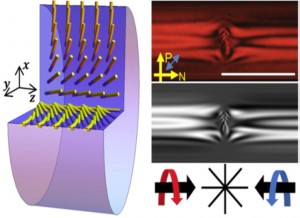Peter Collings, Tom Lubensky and Arjun Yodh (IRG-1) & Alan T. Johnson (Seed)

Fig. 1. (left) Homeotropic (perpendicular) versus planar (parallel) alignment of chromonic liquid crystals due to surface alignment layers. (right) Snapshot of transient stripe texture of CLCs in a capillary with homeotropic alignment.
Chromonic liquid crystals (CLCs) are different from typical LCs used in displays, in part because they “live” in water and thus hold untapped potential for coupling LC phenomenology with biological media. Furthermore, CLCs twist very easily compared to bend and splay deformation, and the consequences of this giant elastic anisotropy are not well understood. Recently, Collings, Lubensky, Yodh & Johnson developed a new alignment layer for CLCs based on parylene (Fig. 1); it enabled homeotropic surface anchoring (i.e., perpendicular anchoring) [1].

Fig. 2. (left) A twisted escaped-radial (TER) director configuration; in the perspective view, yellow rods represent LC directors which escape to the left (West). (right) Schematic diagram of a radial defect between two chiral TER domains, and (top-right) polarization microscopy image of the corresponding defect.
Collings, Lubensky & Yodh applied the scheme to become the first to realize homeotropic surface alignment of CLCs in geometries with curvature. In cylinders, the interplay between anisotropic elasticity, surface anchoring, and confinement geometry caused the CLCs to adopt chiral structures even though they are achiral materials [2]. Experiments in cylinders discovered a new LC structure, the twisted escaped-radial configuration, and new classes of topological defects that arise because twist-handedness and escape-direction can be different (Fig. 2). The work teaches about the origins of chirality or “handedness,” and it suggests a novel mechanism for how nature can be exploited to create right- and left-handed functional structures. [1] J. Jeong et al. (Langmuir, 2014). [2] J. Jeong et al., (under review 2015).
